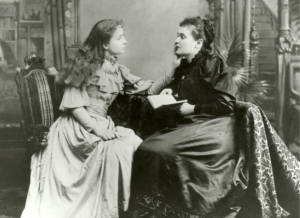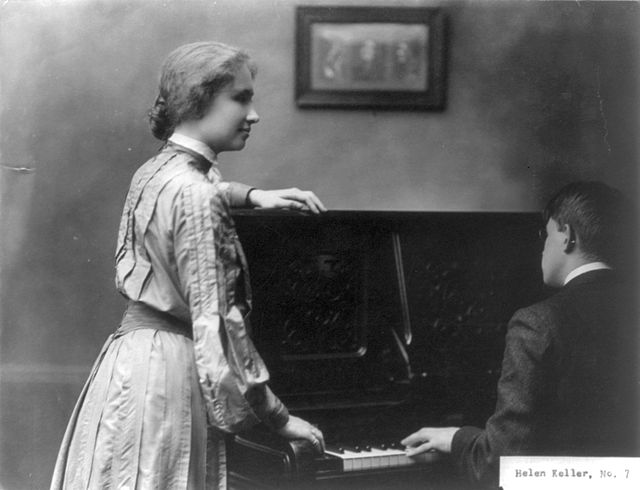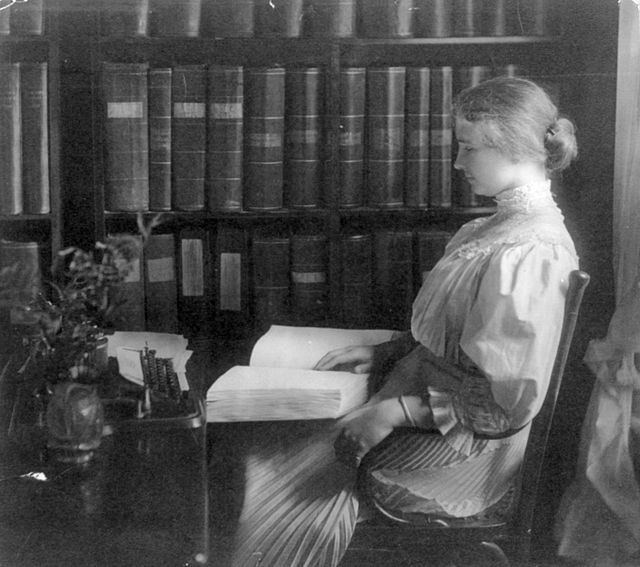People are inspired in many ways: through example, experience, and of course through books! This month, June 27th is Helen Keller Day, which is also the day she was born, and who could be a better example of learning, inspiring achievement, and rising above adversity than Keller?!
Her name is one we all have heard at some point in life. She was known for communicating effectively while blind and deaf, but when I truly researched her life, I found so much more to be inspired by.
Helen Keller was born healthy in June of 1880 in Alabama to Catherine Everett Adams Keller and Henley Keller, an editor for the Tuscumbia North Alabamian. They lived on a homestead called Ivy Green that her paternal grandparents had built decades earlier. Her mother was the daughter of Charles W. Adams a Confederate general and her paternal lineage traced back to Casper Keller a native of Switzerland. Amazingly, one of her Swiss ancestors was the first teacher of the deaf in Zurich. Keller would later mention this in her first autobiography, saying, “There is no king who has not had a slave among his ancestors and no slave who has not had a king among his.”
It was when she was 19 months old that Keller was stricken with an illness that would ultimately take away her sight and ability to hear. Years later in her autobiography, she described that time as being like “at sea in a dense fog.”
During those first few years, she was able to communicate with Martha Washington, the daughter of the family cook. Martha was two years older and able to understand Keller’s signs, and by the time Keller was seven she had over 60 home signs to communicate with her family. She could also distinguish different people by the vibration of their footsteps. Human beings have an innate need to connect with others, and even during this time, Helen found a way to truly be heard and relate to those around her.
For me, it is here where her inspirational story truly begins. In 1886, Charles Dickens published into general circulation a travelogue called American Notes. He documented his travels and observations of American society. What does this have to do with Helen Keller, you may ask? Well, I believe it is a wonderful example of how inspiration has a ripple effect, much like a pebble being thrown into the water pushing the waves to move outward.
Let me explain. Among Dickens' travels, he went to prisons, mental institutions, and the Perkins School for the Blind near Boston where he met Laura Bridgman. Laura was the first deaf-blind person to receive a significant education in English. His account of his meeting with her and her story of success inspired Keller’s mother to reach out and seek advice from a doctor in Baltimore who referred the Kellers to Alexander Graham Bell, another ripple in the waters of inspiration. He was working with deaf children at the time and advised the Kellers to contact the Perkins Institute for the Blind where Bridgman had been educated. The school’s director asked Anne Sullivan, a 20-year-old alumna of the school who was herself visually impaired to become Helen’s instructor and the rest is history.
Sullivan became Helen’s governess and later companion in what was to be a 50-year-long relationship. She arrived at the Keller’s home on March 5th, 1887, and it was a day that Keller would refer to later as her soul’s birthday. Sullivan immediately began to teach Helen how to communicate by spelling words in her hand. At first, Helen struggled with the lessons because she could not understand that each object had a word identifier.
A month later Keller had a breakthrough when her teacher was running water over one hand and motioning in the other hand the word water. She was suddenly aware the motions symbolized the idea of water. As she said later in her autobiography, this was the moment the mystery of language was revealed to her. From that moment she wanted Sullivan to sign all the familiar objects in her world.
Her desire to learn was yet another ripple in the waters of inspiration that led to so much more than one could have imagined for her in those early years. The first step was to attend the PerkinsInstitute for the Blind in 1888 and then in 1894 Keller and Sullivan moved to New York for her to attend the Wright-Humason School for the Deaf. She later would attend The Cambridge School for Young Ladies before gaining admittance, in 1900 to Radcliff College of Harvard University. In 1904 she graduated becoming the first deaf-blind person to earn a Bachelor of Arts degree.
In her effort to communicate with others and the world, Keller learned to speak and learned to listen to others using the Tadoma method. It is a means of listening for blind-deaf individuals and helps them understand what people are saying through the use of touch. Keller also became proficient in braille and fingerspelling and went on to give speeches and lectures about her life and on behalf of the American Foundation for the Blind.
Over the course of her life, Keller wrote 12 books and several articles. She received the Presidential Medal of Freedom in 1964, and she was an effective social and political activist traveling to twenty-five different countries giving motivational speeches about Deaf people’s conditions and supporting the suffrage movement, pacifism, and socialist views. Keller became a world-famous speaker, advocating for people with disabilities and numerous other causes. In 1915 she founded the Helen Keller International organization with George A. Kessler to devote to research in vision, health, and nutrition.
What really resonates with me about Keller’s story is how inspiration is truly a force that moves outward from one person to the next like ripples in the water from a thrown stone. Her life and legacy have inspired many to this day, but there are many that also inspired hers. Charles Dicken’s account of his travels meeting Laura Bridgman and her success learning as a deaf and blind woman inspired Keller’s mother to reach out for education for Helen. Anne Sullivan's experience as a visually impaired young woman made her an excellent teacher and lifelong companion to Helen. Alexander Graham Bell had a great impact on her journey as well. Many do not know that his wife, Mabel Gardiner Hubbard was deaf, and so was his mother, Eliza Bell. This greatly influenced his work and support of Keller’s life.
Yes, inspiration is all around us, and like many other things in life, it can be contagious. It spreads outward from one person to the next. I think Helen Keller’s life is a wonderful example of that. Happy Heavenly Birthday Helen. Your amazing life is still inspiring outward to others even to this day.
Here are some inspiring books written by Helen Keller you can request today:
"Alone we can do so little. Together we can do so much." ~ Helen Keller
Here are more great books about other inspiring people past and present:






Add a comment to: Inspiration is all around us: Celebrating the Life of Helen Keller